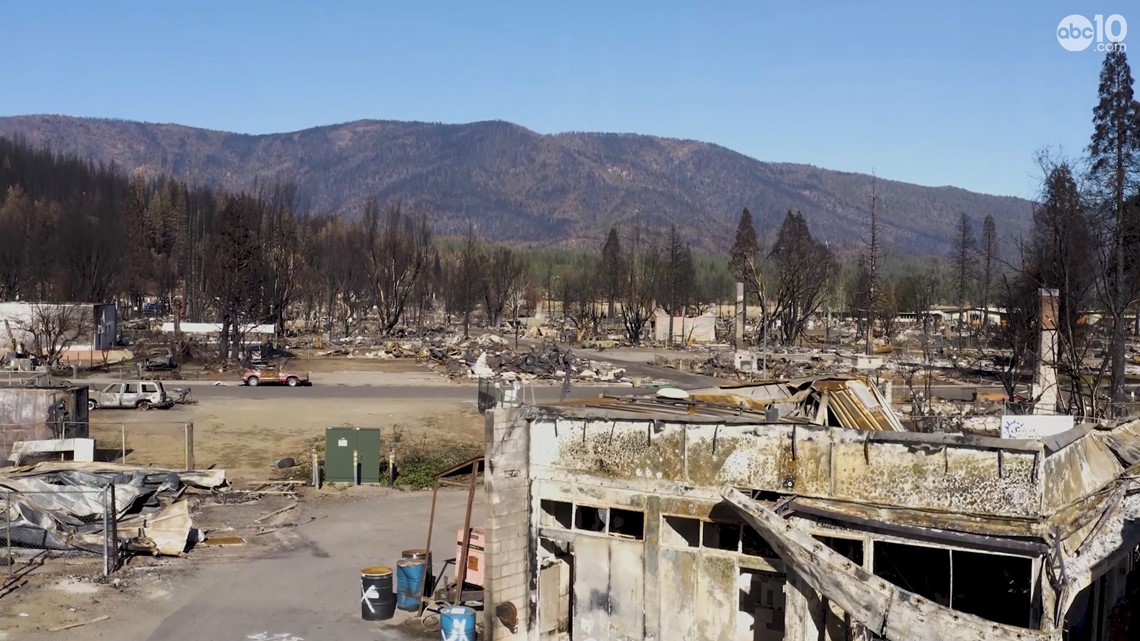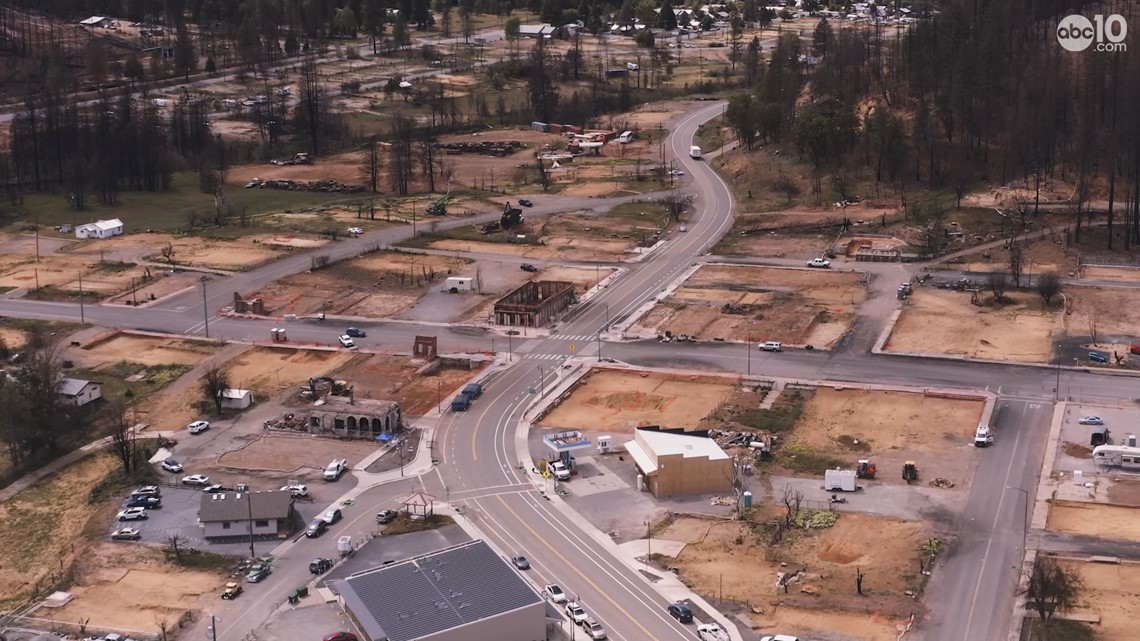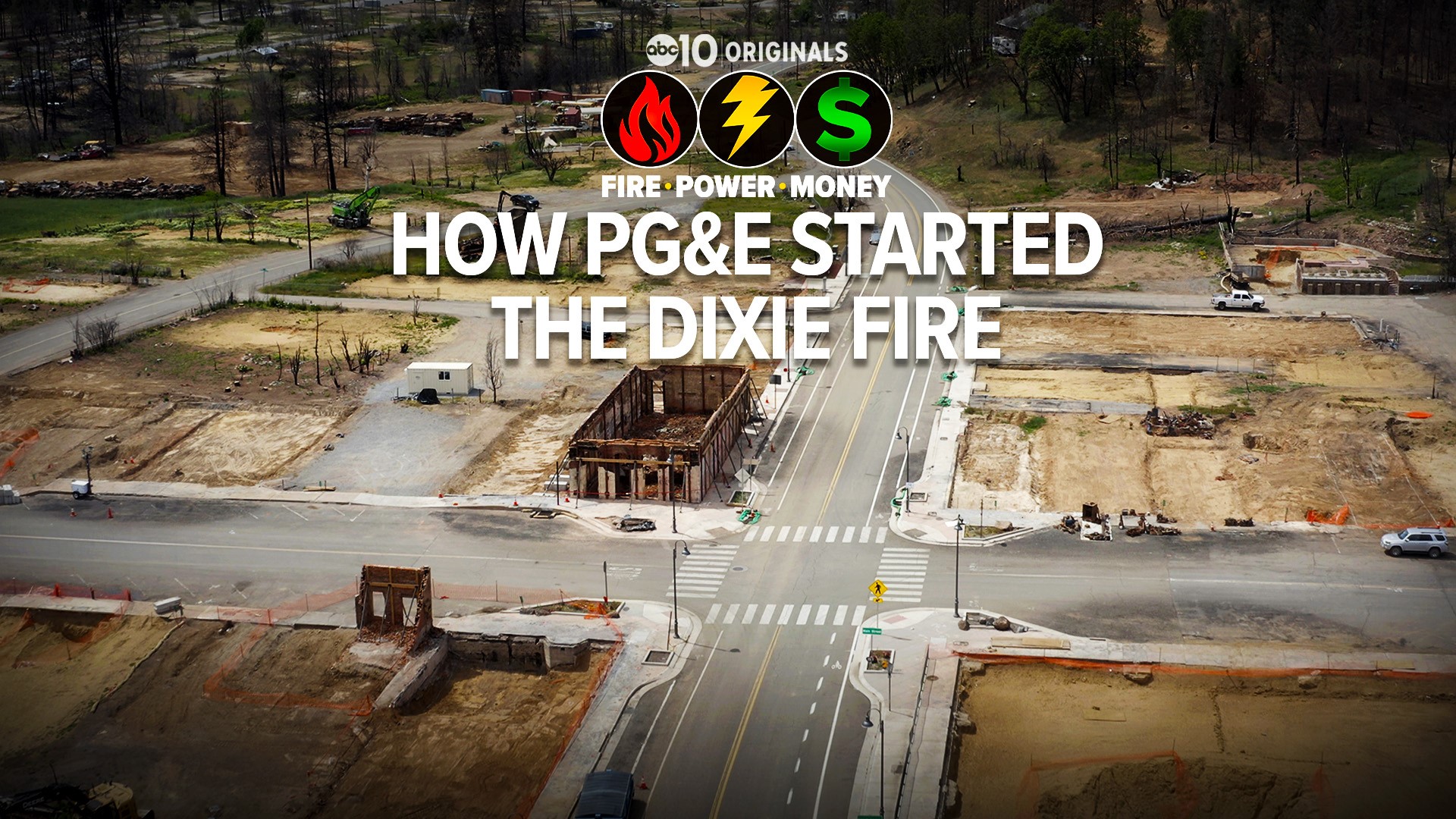GREENVILLE, Calif. — She’d seen mass suffering in wars and disasters during her 16 years as a nun, but it didn’t quite prepare Sue Weber to experience her own town burnt to the ground.
Thanks to advance warning, everyone in Greenville made it out alive. But the 2021 Dixie Fire ended the lives her friends and neighbors used to live.
All the shopkeepers, teachers, plumbers, and artists lost the community for which they worked.
“I think that's the deepest trauma,” Sue Weber said. “I'm no longer any of these things and I have nothing. I think a lot of people are struggling with that.”
Sue sees the struggle up-close as part of her current work, helping the community rebuild through a group called the Dixie Fire Collaborative.
Even if the fire didn’t kill anyone, she firmly believes the aftermath did.
“Right after the fire, a lot of people passed away. A lot of our elderly are passing away,” Weber said. “I think it's because, for them, it's overwhelming.”
The Dixie Fire destroyed an area the size of Rhode Island, burning nearly 1 million acres.
It destroyed lots of places in the 104 days it burned including Canyon Dam, Indian Falls, and half of Lassen Volcanic National Park. But it was the loss of Greenville that got politicians spinning.


“There’s just not words for how us in government haven’t been able to get the job done,” said Rep. Doug LaMalfa (R-California) in an online video posted near the fire when the town burned.
He pointed to poor forest management as the problem behind the fire. When Gov. Gavin Newsom (D-California) visited Greenville, he pointed to a different problem.
“These are climate-induced wildfires,” Newsom said.
Neither politician from either side of the aisle mentioned what actually caused the fire: a corporation that donated to both of their campaigns.
Fire scientists widely agree that climate change and overloaded landscapes are both driving fires to burn more often and more intensely.
But lead prosecutor Marc Noel made clear in an interview that neither problem provided the spark for the Dixie Fire:
ABC10: “Did climate change start this fire?”
Marc Noel, deputy Butte County District Attorney: “No.”
ABC10: “Did forest management start this fire?”
Noel: “No.”
ABC10: “What did start this fire?”
Noel: “PG&E.”
INVESTIGATION FOUND DECAY AND DELAYS
CAL FIRE’s recently-released arson investigation found that the Dixie Fire was caused when a 65-foot tall Douglas Fir fell onto PG&E power lines.


For the full investigation report of the Dixie Fire by CAL FIRE, view below.
PG&E has a legal duty to cut and trim trees that threaten power lines.
“Why did you not see this tree,” asked Noel, who served as lead prosecutor on the case.
Noel said the tree had an obvious wound that PG&E had 13 years to catch, but never did.
By studying the rings of the tree, arborists found the side of the trunk facing the power lines had a big section of bark missing from a wound inflicted in 2008.
The wood inside the trunk was so rotten that it couldn’t support the tree’s weight, causing it to fall onto live power lines.
The tree “should have been discovered and removed” by PG&E, according to CAL FIRE.
Investigators found PG&E also acted with negligence the day the tree broke.
“That tree was on the line – that tree was cooking, and cooking for 10 hours. In a very, very dangerous area,” said Butte County District Attorney Mike Ramsey.
On July 13, 2021, PG&E’s computers flagged trouble on the powerline near Cresta Dam in the Feather River Canyon at 6:48 a.m., presumably when the tree fell.
“No sense of urgency was demonstrated by PG&E to determine the cause of the fault in a fire-prone area during a severe time of year,” CAL FIRE concluded.
It took almost ten hours for a PG&E employee to finally get there.
WHY WAS THE POWER LEFT ON?
When trouble man Scott Campbell arrived at 4:40 pm, he says he noticed the tree and a small fire, which he tried to put out on his own by sliding down the steep hillside with a water canister.
“He risked his own safety by trying (to) stop the spread of the fire,” wrote Ed Swanson, Campbell’s attorney.
Prosecutors did not charge Campbell. They say PG&E set him up to fail.
It took PG&E four hours to even assign the problem to Campbell, who was based in Chico. Before that, PG&E had assigned it to the wrong maintenance yard in Quincy.
“They basically wasted about three and a half hours doing nothing,” Noel said.
Prosecutors do have questions about why Campbell did not notice the tree before driving up a long dirt road to find it.
The tree was just downhill from a pair of blown fuses, which Campbell was able to see with his binoculars from Highway 70 near the Cresta Dam.
ABC10 visited the location and confirmed that the terrain would not have obstructed the view of the location where the tree was resting on the power lines.
“I can't imagine that tree wasn't visible,” Noel said.
Campbell decided to drive up to the blown fuses but did not switch off the power line before he did. Prosecutors point out there was a switch nearby along the highway.
“Based on what he did see, our client had no reason to believe the situation presented a fire danger, and as a result, he didn’t have the authority to cut off the power at the switch,” Swanson wrote. “Instead, he went up the hill to replace the fuses. It was only when he arrived that he saw a tree on the line and evidence of a fire.”
His route was delayed by road work, but he knew it was going to be a long drive.
“It’s in the worst damn spot,” Campbell told grid operators after being assigned the job. “It takes about an hour and a half once you get on that shitty-ass road to get to the fuses.”
A COMPANY FAILURE
He wasn’t the only person at PG&E who could have switched off the line. In fact, others considered doing so.
94 miles away, at an unmarked PG&E facility in the Sacramento suburb of Rocklin, power grid operators thought about turning off the power line remotely. They decided not to.
“If [PG&E] had gotten up there earlier. If they used any of the tools that were available to them, whether it be helicopters, drones, or just simply cutting off the power to that section of the line until they could get there… there would have been no fire,” Noel said.
This is where it’s impossible to ignore that PG&E, the company, has a criminal record from prior deadly disasters.
The Dixie Fire sparked about five miles up the same canyon where the Camp Fire started in 2018.
The year before the Dixie Fire, PG&E pleaded guilty to the felony manslaughter of 84 people in and around Paradise.
PG&E power lines have been named as the cause of sparking big fires every fire season since 2017.
“We've become a society that we don't hold anybody accountable anymore,” Sue Weber said. “So how many times does it have to happen?”
WHY DIDN’T PG&E FACE NEW CHARGES?
Butte County District Attorney Mike Ramsey says his team could have proved PG&E guilty again in the Dixie Fire but opted for a larger amount of money from PG&E in a civil settlement instead.
“[In the] Camp Fire, we put our foot down because it's different. People died. You can't just have a civil settlement,” Ramsey said.
Unlike the Camp Fire, the district attorneys of all five counties that burned in the Dixie Fire agreed to allow PG&E to settle without admitting criminal wrongdoing.
In exchange, PG&E agreed to pay damages more quickly to the people whose homes burned down.
“Get money back into that community,” Ramsey said.


The district attorneys say they were motivated by a desire to avoid a repeat of the Camp Fire settlement, which left PG&E’s crime victims still waiting for payment almost four years later.
Sue Weber is glad for any money that’ll help Greenville rebuild.
The nonprofit collaborative she helps run got $3 million in the deal, but the outcome still doesn’t feel right.
“It's a game,” Weber said. “It feels just like a game. And it's all about money. And it's all about power. That's the bottom line.”
CALLS FOR TOUGHER LAWS GO UNANSWERED
Prosecutors argue the playing field is heavily tilted in PG&E’s favor.
If they’d decided to press charges and successfully convicted PG&E of crimes in the Dixie Fire, prosecutors say PG&E’s maximum punishment would have been less than $330,000.
After Paradise, when PG&E paid a fine of just $10,000 per manslaughter.
The judge said a human being convicted of the same crimes would have been stripped of their freedom, and sent to prison for 90 years.
After that outcome, prosecutors called on state lawmakers in Sacramento to pass tougher penalties. It hasn’t happened.
“The ball's in their court at this point,” Noel said.
Lead Camp Fire prosecutor Marc Noel says he’s not sure bigger fines would be enough. He’d like the ability to jail PG&E executives if they don’t keep their safety promises.
“To me, that's the only real thing that's going to stop this,” Noel said. “If the people who are making the decisions of PG&E have consequences.”
STATE FOCUSED ON PROTECTING PG&E, NOT PUNISHING IT
ABC10’s multi-year investigation of the state government’s response to the Camp Fire revealed that the legislature passed laws not to punish PG&E, but to protect it.
In the 2019 law known as AB 1054, California created a $21 billion insurance program for PG&E and the two other major for-profit power companies.
Our investigation found that Gov. Gavin Newsom’s office hired a law firm that previously represented PG&E to draft the bill, which was rushed through the legislature on a two-week timeline in 2019.
PG&E plans to use the new insurance to help cover the cost of damage it caused in the Dixie Fire.
Asked earlier this year whether that should be allowed, AB 1054 bill sponsor Asm. Chris Holden let a set of elevator doors close without answering the question.
In a written statement, PG&E claimed that it “acted as a prudent operator” in the Dixie Fire and pointed out that it had “an approved safety certificate,” granting it access to the insurance created under AB 1054.
Prosecutors disagree. They argue PG&E’s behavior in causing the Dixie Fire should trigger language in AB 1054 that can be used to require the company to pay back the money.
It will be up to the California Earthquake Authority, which administers the fund, to decide whether PG&E’s “actions or inactions” amount to “conscious or willful disregard of the rights and safety of others.”
“In that area, that time of year, waiting 10 hours was obviously willful and conscious disregard for the safety of persons and property,” Noel said.
It’s not up to prosecutors. AB 1054 leaves it up to third parties to prove PG&E acted improperly.
AB1054 offered PG&E the ability to earn safety certificates for its wildfire plans, regardless of its actual safety record. If it has the certificate, PG&E is automatically presumed to have acted reasonably.
“The laws are not made for the average American,” Sue Weber said.
Despite its record of 91 felonies and an annual string of disasters, PG&E remains free. And it remains in power.
PG&E CEO Patti Poppe declined repeated requests to be interviewed. The company said it has since made changes to policies and safety settings that would have prevented the Dixie Fire.
In the settlement, PG&E agreed to pay for an independent monitor who’ll report to prosecutors for the next five years.
Describing that part of the settlement, Butte District Attorney Mike Ramsey reached for a favorite Ronald Reagan line: “Trust, but verify.”
But for many disaster survivors, trust in PG&E is long gone.
“If you don't hold somebody accountable, they will never be accountable,” Sue Weber said.
“They will think they can do whatever they want. And they're right. They can.”
GO DEEPER: This story is part of ABC10's FIRE - POWER - MONEY reporting project. If you have a tip that could reveal more about California's crisis with utilities and wildfires, please contact investigative reporter Brandon Rittiman at brittiman@abc10.com.
Watch more: INVESTIGATION: Solano County mishandled death of PG&E worker in LNU wildfire | Fire - Power - Money



















